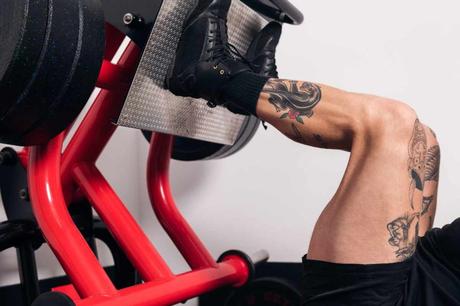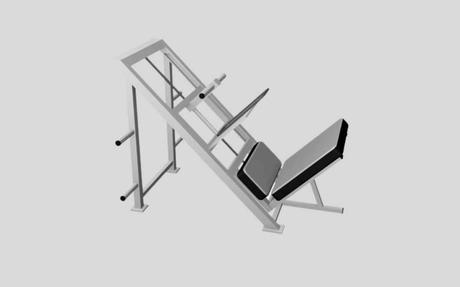The leg press and hack squat are both excellent exercises for developing strong leg muscles. But which one is for you? Read on to see the pros and cons of each.

I’m not going to lie: I love leg presses.
There’s just something wonderful about pressing serious amounts of weight (bodyweight x2?!?!) on the leg press machine to prove that my leg muscle training is yielding the results I want.
But over my years as an athlete, strength trainee, and personal trainer, I’ve come to understand that variety isn’t just the spice of life—it’s also critical for overall fitness.
Think about it: if you only develop power in one muscle in one specific range of motion (in this case, leg presses), what happens when you need to engage other muscles in an entirely different range of motion?
That’s why I’m always looking for a variety of (potentially) equally effective exercises to incorporate into my training sessions.
In this guide, we are going to take a closer look at the leg press vs. hack squat exercises.
I’ll compare the two to find similarities and differences, examine the pros and cons, and help you understand why both leg presses and hack squats are critical components of a healthy workout.
Get ready for a deep dive into two of the most popular lower body exercises around!
The Hack Squat – Overview
The hack squat is one of my favorite leg press alternatives when I want to compliment my regular squats with something different than the leg press machine.
It’s typically performed using the hack squat machine, though you can do a variation using just a barbell and a squat rack.

For the standard machine-based hack squat, you simply step onto the platform, lean back (usually to a 45-degree angle), and lift the weight off its supports. Slowly lower until your knees hit a 90-degree angle, then press back up to complete one repetition.
(For the barbell/squat rack variation, place a barbell on your shoulders and lean back against the rails of a squat rack. Slide down until you hit the 90-degree angle, then press back up. It’s a fully vertical variation on the inclined hack squat, allowing you to do the exercise even without a machine.)
Hack Squat Pros:
- These squats are done with support for your lower body, but they still engage the secondary/stabilizer muscles in your hips and pelvic region throughout the entire range of motion.
- They isolate the quads for more efficient strength generation in your biggest leg muscle group.
- They train the muscles around your knees more effectively, helping to “bulletproof” one of the most vulnerable joints in your body.
- Excellent hip hinge training.
Hack Squat Cons:
- Higher risk of knee strain than most other lower body exercises.
- Unnatural position may be uncomfortable, particularly for those with lower back injuries.
The Leg Press – Overview
The leg press is a classic, performed using a leg press machine (though there is a variation involving resistance bands).
With the leg press, you lie back on the seat, place your legs on the sled above you, and push upward (at a 45-degree angle) to raise and lower the weight.

It’s one of the easiest leg exercises you can do, and one of the safest. There are lots of benefits to the leg press.
Leg Press Pros:
- Easy and safe even for beginner trainees. Can help to build real strength more quickly.
- Isolate your lower body to target glutes, calves, quads, hips, and hamstrings.
- Tons of leg press foot placement options for targeting different muscles
- Less risk of lower back injury because the seat/bench is supporting your weight, thus eliminating the need for your spinal muscles to engage throughout the press.
- Great hip flexion.
Leg Press Cons:
- Muscular strength is more isolated and less “functional”, and won’t always translate into the same power for other leg exercises. Your quads may grow stronger, but there are many other exercises far more effective at strengthening the other critical leg muscles (glutes, hamstrings, hips, and calves).
- Less challenge to your central nervous system, meaning less improvement in your balance and mobility.
- Less hip extension.
The Main Differences Between the Hack Squat and Leg Press
There are four key things that separate leg presses from hack squats.
They are:
Difference #1: Biomechanics of the Exercise
With hack squats, your feet remain firmly in place on the platform, and your legs extend to lift your bodyweight plus the weight loaded onto the machine/barbell.
With leg presses, your feet still remain firmly in place on the sled, but when your legs extend, they lift the weight of just the plates loaded on the press machine.
The biomechanics of these two exercises are mostly similar, but there’s one big difference: gravity.
With leg presses, you’ve got your entire body beneath the weight pushing upward against gravity. Though the focus is primarily on your legs, you have greater muscle power available to work against the combined forces of gravity and the weights.
With hack squats, your legs are pushing your entire body against gravity and the weight on your shoulders. Because of the angle of the incline, your legs end up doing all of the work—which is better for quadriceps muscle isolation, but also place more strain on your knees.
Difference #2: Machines Used
The leg press machine features a comfortable bench/seat that you sit on and lean back against. You place your legs on the sled and press it upward, setting it sliding up and down the rails.
The hack squat machine features an angled platform and a back support/shoulder cushion that rests on your upper body. When you squat, the machine slides up and down the rails, with the weight resting squarely on your shoulders.
Both machines are angled at 45-degrees. However, with hack squats, your lower quads and knees end up doing most of the pushing work, while leg presses engage your glutes, hamstrings, and upper quads more effectively.
Difference #3: Load Placement
With hack squats, the weight is loaded entirely on your shoulders, which means that your torso musculature is engaged in order to maintain a straight (erect) spine while performing the squats. At the lowest point of the exercise, the weight is primarily resting on your lower quads and knees, with minimal engagement in the upper quads, hamstrings, or glutes.
With leg presses, the weight is loaded entirely on the bottom of your feet. There is no engagement of the torso musculature needed, no effort exerted into maintaining proper upper body posture. All of the focus is on the lower body. Also, the position of the leg press allows for more natural recruitment of the lower body muscles (including hips, hamstrings, and glutes) throughout the entire “push” movement.
Difference #4: Muscles Targeted
Hack squats chiefly target the quadriceps muscles, particularly the lower quadriceps (just above the knees).
However, because of the load placed on the upper body (by the weight resting on your shoulders), the core muscles (spinal erectors and abdominals) also have to engage to maintain proper posture.
Leg presses focus entirely on the lower body, with virtually no core engagement. The quads and glutes are the primary target of leg presses, but slight adjustments to your foot placement can target your hamstrings, hips, and calves more effectively.
Leg Press vs Hack Squat – FAQs
What’s better for improving the squat – leg press or hack squat?
To squat more, squat more.
Sounds almost too simplistic, right? But it’s absolutely true.
While leg presses will help you to develop raw power in your legs, the pressing movement may not translate as efficiently into squatting.
On the other hand, hack squats put you through the same range of motion as front or back squats, and strengthen the core muscles that are needed for proper squat posture.
At the end of the day, hack squats will improve your front/back squat performance fractionally better than leg presses.
Which exercise is better for athletic performance?
Most of the studies comparing leg presses to squats (like this one, for example) examine the benefits of regular front or back squats, not hack squats. Research has shown that for leg muscle activation, nothing can beat good old front squats.
Some research into hack squats has shown that they are as effective as back squats, which are considered “second best” to front squats.
As I made clear above, squats (of all types, even hack squats) do encourage more muscle activation in the trunk (abs and lower back), which helps to translate into better core strength across all exercises and activities.
At the end of the day, hack squats will be better for athletic performance overall. However, they are also a riskier proposition and more likely to cause injury than leg presses.
The Bottom Line
After comparing hack squats to leg presses, I’m inclined to believe that leg presses are the smarter choice for a variety of reasons.
Yes, hack squats do help you to squat more, and they tend to be better for overall athletic performance.
However, given the higher chance of injury (especially to the knees, which are always a problem for big guys like me) and the reduced engagement of all the lower body muscles, they strike me as a riskier proposition.
Leg presses may be fractionally less effective, but the fact that they’re safer and allow me to lift significantly more weight makes them my leg day addition of choice.
More Guides Like This:


